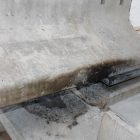4 Methods of Condition Survey for Bridge Decks
Exposed Concrete Decks suffer from various deterioration mechanisms; i.e. freezing and thawing, corrosion. The most significant consequence is the delamination of concrete, which could eventually trigger other damage mechanism, such as corrosion. The maintenance of deck slabs is quite challenging mainly because it normally involves large areas;








